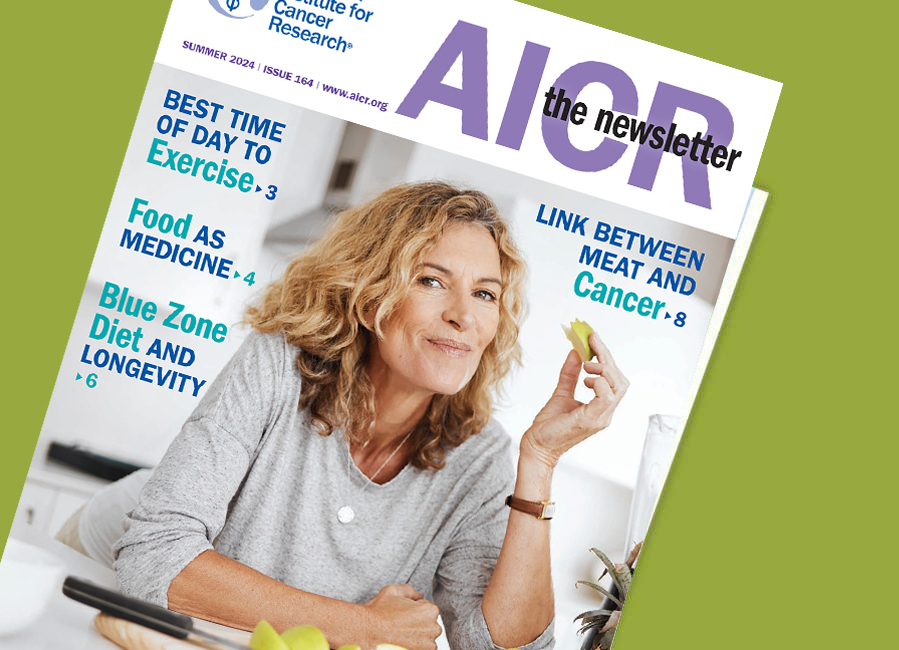Key Takeaways
- Blue Zones are areas of the world where people live the longest. Healthy lifestyle habits like eating well, being active and having personal connections all help.
- The Blue Zone diet is part of the longevity secret. It’s mostly plant-based and includes lots of vegetables, whole grains, nuts and fish
- Eating according to AICR’s New American Plate is very similar to the eating pattern in the Blue Zone diet. Both plans focus on eating more plants.
We all know someone who seems like they must drink from the fountain of youth. They act younger than their years, are always active and remain healthy despite their age. Could their secret be their Blue Zone habits? Let’s find out.
What Are the Blue Zones?
Blue Zones are five areas of the world with the largest percentage of people who live until age 100 or longer. The Blue Zone map includes:
- Loma Linda, California
- Nicoya, Costa Rica
- Ikaria, Greece
- Sardinia, Italy
- Okinawa, Japan
The Blue Zones were identified by Dan Buettner, a journalist who partnered with National Geographic and the National Institute on Aging to study habits of people living in these regions.
Yes, the Blue Zone science is “light” compared to research funded and published by AICR. But Buettner’s bestselling books and recent Netflix Blue Zones documentary Live to 100: Secrets of the Blue Zones has boosted the popularity of this concept.
Here at AICR, we had to check it out, even though clinical studies are lacking. What we found was that the dietary pattern closely aligns with our research-based recommendations in the New American Plate. The bottom line? Eat more plants.
What Is the Blue Zone Diet?
A Blue Zone diet plan isn’t an on-and-off diet. It’s a long-term way of eating. The cuisines differ from region to region, and you will have different vegetables, grains and protein options in Italy vs. Japan vs. Costa Rica. But the eating patterns in all of these locales have several things in common, which also fit with AICR’s Cancer Prevention Recommendations:
- Meals and snacks feature lots of fruits and vegetables. Blue Zone diets aren’t necessarily vegan, but they are plant-forward.
- Protein comes from beans and a small amount of fish. Centenarians include at least a half-cup of lentils, chickpeas, soy and beans daily, and eat red meat a few times a month.
- A generous handful of nuts is enjoyed daily.
- Whole grains replace refined white flour. Whole wheat, barley and oats are popular choices.
- Dessert is reserved for special occasions.
- Water is the primary thirst-quencher, along with tea and coffee. You won’t find sweetened soft drinks on Blue Zone menus.
It’s easy to notice similarities between a Blue Zone diet and other healthy eating patterns, such as the Mediterranean diet and AICR’s New American Plate. While the Blue Zone diet isn’t backed by research, other studies show that plant-based diets with a reduced emphasis on meat, added sugars and highly processed foods, help lower cancer risk.
More Than a Longevity Diet
Beyond diet, people in Blue Zones follow several healthy lifestyle habits, which may account for their lifespan:
- They incorporate physical activity into their daily routine by gardening, running errands on foot, hiking or riding a bike.
- They live purposely and have a reason to get out of bed each morning. Many do volunteer work or care for others.
- They participate in daily stress-reducing activities, like praying, meditating, practicing gratitude or taking a nap.
- They are closely connected to friends, family and a faith-based community. There is no guarantee that Blue Zone lifestyle habits will help you hit the century mark, but it’s easy to see how these small, healthy habits add up to promote a longer, healthier and more vibrant life.
The Concept of Hara Hachi Bu
In Okinawa, there is a popular phrase that relates to eating: hara hachi bu. It’s a gentle reminder to stop eating when you feel 80 percent full. It helps eliminate that bloated, overstuffed feeling. Instead, you can pay attention to your appetite and eat more slowly and mindfully. As Buettner explains, “an American says, ‘I’m full’ and an Okinawan says, ‘I’m no longer hungry.’” It’s a different mindset and it makes a big difference.
Here are some Blue Zone recipes that fit well into the plant-based diet concept:





